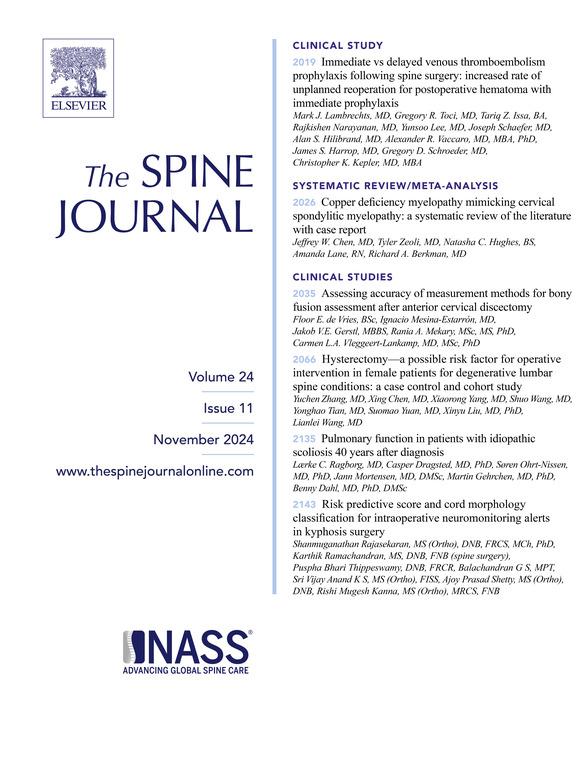19. Partial uncinatectomy combined with anterior cervical discectomy and fusion for the treatment of one-level cervical radiculopathy: analysis of clinical efficacy and sagittal alignment
IF 4.7
1区 医学
Q1 CLINICAL NEUROLOGY
引用次数: 0
Abstract
BACKGROUND CONTEXT
Biomechanical studies have demonstrated that uncovertebral joint contributes to segment mobility and stability to a certain extent. Simultaneously, osteophytes arising from the uncinate process are a common cause of cervical spondylotic radiculopathy (CSR). For such patients, partial uncinatectomy (UT) may be required. However, the clinical efficacy and sagittal alignment of partial UT during anterior cervical discectomy and fusion (ACDF) have not been fully elucidated.
PURPOSE
This study aims to assess the comparative clinical efficacy, sagittal alignment outcomes, and safety of ACDF with and without partial UT, utilizing zero-profile implants.
STUDY DESIGN/SETTING
A retrospective cohort study comparing clinical and radiological outcomes, and complication rates, following single-level anterior cervical discectomy and fusion with and without partial uncinatectomy.
PATIENT SAMPLE
Eighty-seven patients who underwent single-level ACDF between July 2014 and December 2018 were retrospectively included, divided into groups with (n=37) and without (n=50) partial uncinatectomy.
OUTCOME MEASURES
Outcome measures included preoperative and postoperative clinical scores (VAS, NDI, JOA), radiological parameters of cervical sagittal alignment (C2-7 SVA, St-SVA, T1 slope, cervical lordosis, FSU angle), fusion rate, and the incidence of postoperative complications (dysphagia, adjacent segment degeneration, subsidence).
METHODS
This retrospective cohort study included 87 patients who underwent single-level ACDF between July 2014 and December 2018. Based on surgical technique, patients were divided into two groups: ACDF with partial UT (n=37) and ACDF without UT (n=50). Detailed perioperative data, radiological parameters, clinical outcomes, and complications were analyzed. Key cervical alignment metrics, including C2–7 sagittal vertical axis (SVA) and sella turcica–C7 SVA (St-SVA), were measured preoperatively and at follow-up. Pain and functionality were evaluated using visual analogue scale (VAS) for neck and arm pain, Neck Disability Index (NDI), and Japanese Orthopaedic Association (JOA) scores. Statistical significance was set at p<0.05.
RESULTS
Both groups demonstrated substantial postoperative improvements in pain relief and neurological function. Preoperative VAS arm scores were significantly higher in the UT group (p=0.038), reflecting a more severe symptom burden. Postoperatively, no differences were observed in neck pain VAS, NDI, or fusion rates between groups. At final follow-up, however, patients in the UT group showed reduced recovery in cervical sagittal alignment, with significantly higher residual C2–7 SVA and St-SVA values compared to the non-UT group (p=0.034 and p=0.033, respectively). Both groups experienced comparable rates of complications, including dysphagia, adjacent segment degeneration (ASD), and cage subsidence, with no revision surgeries required.
CONCLUSIONS
Our result indicates that ACDF using a zero-p implant with or without partial UT both provide satisfactory clinical efficacy and acceptable safety. However, additional partial UT may have a negative effect on cervical sagittal alignment.
FDA Device/Drug Status
This abstract does not discuss or include any applicable devices or drugs.
19. 棘突部分切除术联合颈前路椎间盘切除术融合治疗一节段颈椎神经根病:临床疗效及矢状位对齐分析
生物力学研究表明,非椎体关节在一定程度上有助于节段的活动和稳定。同时,钩突骨赘是神经根型颈椎病(CSR)的常见病因。对于这样的患者,可能需要部分切除(UT)。然而,部分UT在前路颈椎椎间盘切除术和融合(ACDF)中的临床疗效和矢状位排列尚未完全阐明。目的:本研究旨在评估使用零侧位种植体的ACDF与不使用部分UT的ACDF的临床疗效、矢状面对齐结果和安全性。研究设计/背景:一项回顾性队列研究,比较单节段前颈椎间盘切除术和融合伴和不伴部分棘突切除术后的临床和影像学结果以及并发症发生率。回顾性纳入2014年7月至2018年12月期间接受单级别ACDF的87例患者,分为(n=37)组和(n=50)组。结果测量包括术前和术后临床评分(VAS、NDI、JOA)、颈椎矢状面对齐的影像学参数(C2-7 SVA、St-SVA、T1斜率、颈椎前凸、FSU角)、融合率和术后并发症发生率(吞咽困难、邻近节段退变、下沉)。方法本回顾性队列研究纳入了2014年7月至2018年12月期间接受单水平ACDF治疗的87例患者。根据手术技术将患者分为ACDF合并部分UT (n=37)和ACDF不合并UT (n=50)两组。分析了详细的围手术期资料、影像学参数、临床结果和并发症。术前和随访时测量关键颈椎对准指标,包括C2-7矢状垂直轴(SVA)和蝶鞍- c7 SVA (St-SVA)。采用视觉模拟量表(VAS)评估颈部和手臂疼痛、颈部残疾指数(NDI)和日本骨科协会(JOA)评分。差异有统计学意义,p < 0.05。结果两组患者术后疼痛缓解和神经功能均有明显改善。术前UT组VAS臂评分显著高于对照组(p=0.038),反映出UT组症状负担加重。术后,两组间颈部疼痛VAS、NDI、融合率均无差异。然而,在最后的随访中,UT组患者的颈椎矢状位线恢复较低,与非UT组相比,残留的C2-7 SVA和St-SVA值明显更高(p=0.034和p=0.033)。两组的并发症发生率相当,包括吞咽困难、邻近节段退变(ASD)和笼形沉降,均无需翻修手术。结论采用零p种植体,加或不加部分UT均可获得满意的临床疗效和可接受的安全性。然而,额外的部分UT可能对颈椎矢状位对齐有负面影响。FDA器械/药物状态本摘要不讨论或包括任何适用的器械或药物。
本文章由计算机程序翻译,如有差异,请以英文原文为准。
求助全文
约1分钟内获得全文
求助全文
来源期刊

Spine Journal
医学-临床神经学
CiteScore
8.20
自引率
6.70%
发文量
680
审稿时长
13.1 weeks
期刊介绍:
The Spine Journal, the official journal of the North American Spine Society, is an international and multidisciplinary journal that publishes original, peer-reviewed articles on research and treatment related to the spine and spine care, including basic science and clinical investigations. It is a condition of publication that manuscripts submitted to The Spine Journal have not been published, and will not be simultaneously submitted or published elsewhere. The Spine Journal also publishes major reviews of specific topics by acknowledged authorities, technical notes, teaching editorials, and other special features, Letters to the Editor-in-Chief are encouraged.
 求助内容:
求助内容: 应助结果提醒方式:
应助结果提醒方式:


